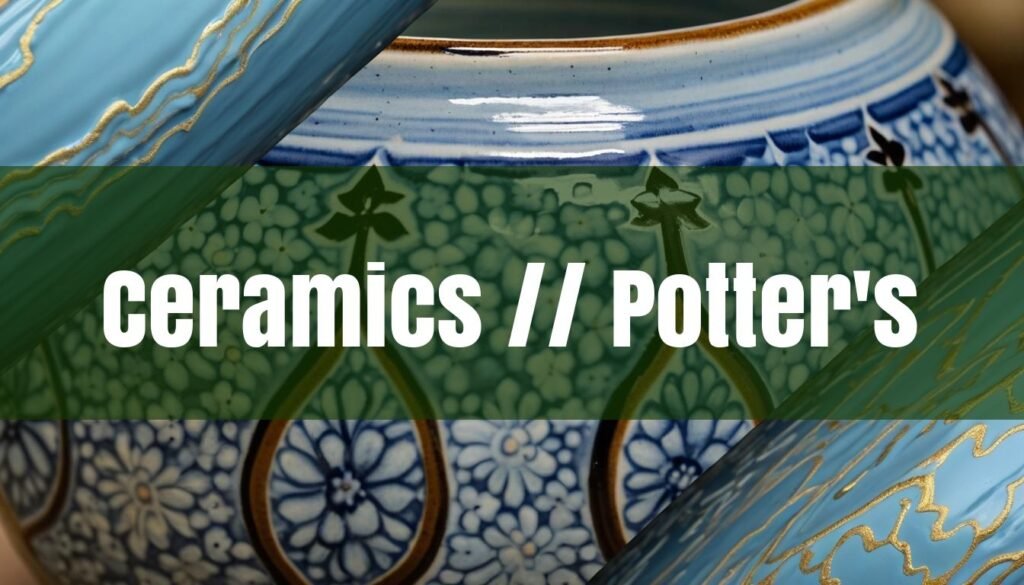The world of ceramics is vast and varied, with a rich history and a vibrant present. Central to this art form is the clay itself – the very foundation upon which ceramic creations are built. Understanding the different types of clay is crucial for any potter, whether a beginner or an experienced artist, as each clay possesses unique properties that make it suitable for specific purposes. This article will explore the primary types of clay used in ceramics, delving into their characteristics, firing temperatures, and ideal applications.
Types of Clay
The diversity of clay is remarkable, with each type offering a distinct set of properties that influence its workability, firing behavior, and the final aesthetic of the ceramic piece. While there are numerous variations and blends, clay is broadly classified into six main types: earthenware, stoneware, ball clay, fire clay, porcelain, and air-dry clay. Learn more about these types of clay.
Earthenware is often the first clay encountered by beginner potters due to its forgiving nature and ease of use. This clay is known for its high plasticity and smooth texture, making it suitable for both hand-building and wheel-throwing techniques. Its ease of use makes it very popular for beginners. Earthenware is characterized by its relatively low firing temperature, typically between 1,745°F (950°C) and 2,012°F (1,100°C). More information on Earthenware. After firing, earthenware remains porous, meaning it will absorb liquids unless sealed with a glaze. It is often used for decorative ceramics, terracotta pots, and beginner pottery projects. Beginner potters love working with Earthenware. The fired color of earthenware can range from a rich red to a warm brown, adding to its rustic appeal. Rustic Appeal.
Stoneware is a versatile and durable clay prized for its strength and water resistance after firing. Stoneware is a potters favorite. Its firing temperature is higher than earthenware, typically ranging from 2,000°F (1000°C) to 2,516°F (1380°C). Firing temperatures of Stoneware. Stoneware becomes stone-like and non-porous when fired, making it ideal for functional pottery such as dinnerware, mugs, and vases. Functional Pottery. It can withstand heat, making it safe for use in microwaves and ovens. Stoneware clays often appear white or gray when wet, but the fired color can vary depending on impurities present in the clay. Unlike porcelain, which is almost always white, stoneware can be found in various colors, including gray and brownish tones. The colors of Stoneware.
Ball clay is known for its extreme plasticity, fine particle size, and high organic content. Ball Clay. Due to its high shrinkage rate during firing, it is rarely used alone but is instead added to other clay bodies to increase their workability and strength. Ball Clay is used as an additive. Ball clay typically contains kaolinite, mica, quartz, and other organic matter. What makes up Ball Clay. While ball clay is not frequently used on its own, it is commonly used in casting slips and as an additive to other clay bodies to enhance their plasticity and binding qualities. It turns a light buff color or fine white color when fired correctly. The colors of Ball Clay.
Fire clay is a refractory clay, meaning it can withstand extremely high temperatures without deforming or melting. Fire Clay is resistant to heat. Its firing range begins at approximately 2,912°F (1,600°C). Fire clays are known for their purity, containing very few particles of other components. Purity of Fire Clay. Because of its heat resistance, fire clay is often used in the construction of kilns and for making refractory bricks.
Porcelain is often considered the most refined and delicate of all clay types. It is known for its purity, translucence, and smooth, white finish after firing. Porcelain, delicate and refined. Porcelain is typically made from kaolin, a pure white clay mineral. Kaolin and Porcelain. It requires high firing temperatures, usually between 2,381°F (1,305°C) and 2,455°F (1,346°C), to achieve its characteristic vitrification and translucency. Firing temperatures of Porcelain. Porcelain is challenging to work with due to its low plasticity and tendency to warp or crack during firing. It is often used for fine china, sculptures, and high-end pottery where a delicate and elegant appearance is desired. There are three types of porcelain: hard-paste, soft-paste, and bone china, each with a slightly different composition and firing temperature. The different types of Porcelain. You can also explore the story of Chinese porcelain for more information.
Air-dry clay is a popular choice for beginners and hobbyists because it hardens at room temperature without the need for a kiln. Air Dry Clay, no Kiln needed. This clay is typically made from a mixture of natural clay, binders, and fibers. While air-dry clay is easy to use, it is not as durable or water-resistant as kiln-fired clay. It is best suited for sculpting and decorative projects that do not require high strength or functionality.
Firing Temperatures
The firing temperature is a critical factor in ceramics, as it determines the final properties of the clay. Each type of clay has a specific firing range within which it reaches its optimal hardness, durability, and desired aesthetic qualities. Understanding these temperature ranges is essential for achieving successful and long-lasting ceramic pieces. Kiln firing charts.
Earthenware is a low-fire clay, meaning it matures at relatively low temperatures. The typical firing range for earthenware is between 1,745°F (950°C) and 2,012°F (1,100°C). Earthenware firing temperatures. Firing earthenware at these lower temperatures results in a porous and relatively soft final product.
Stoneware is a mid- to high-fire clay, requiring higher temperatures to achieve its characteristic strength and water resistance. The firing range for stoneware typically falls between 2,192°F (1,200°C) and 2,372°F (1,300°C). Firing temperatures for Stoneware. These high temperatures cause the clay to vitrify, creating a dense, durable, and non-porous ceramic piece.
Porcelain is a high-fire clay that requires the highest temperatures to reach its full potential. The firing range for porcelain is generally between 2,381°F (1,305°C) and 2,455°F (1,346°C). Firing temperatures of Porcelain. At these temperatures, the clay becomes translucent and develops its signature glass-like finish. Pure kaolin, the primary component of porcelain, has an even higher maturing temperature of 3,272°F (1,800°C). Maturing temperatures of Kaolin. If you’re interested in learning more, check out this guide to firing temperatures for potters.
Additives and Processing Techniques
To modify the properties of clay and enhance its workability, potters often incorporate various additives and processing techniques. These adjustments can improve plasticity, reduce shrinkage, alter the firing temperature, or achieve specific aesthetic effects. Common additives include sand, grog (fired and ground clay), and organic materials. Grog can reduce shrinkage and increase the strength of the clay body. Additives and their effect on the clay. Processing techniques such as wedging (kneading the clay to remove air pockets and ensure uniform consistency) and levigation (separating clay particles by density in water) are also used to prepare clay for different ceramic applications. By carefully selecting and processing clay, potters can tailor the material to meet the specific requirements of their projects, resulting in ceramic pieces that are both functional and beautiful.





